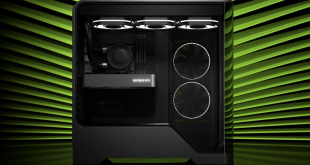.
Hardware but no software
Early efforts were just that, efforts.
Not only did many games not show a noticeable benefit, but many games went far slower when you inserted a second card. This was especially true for ATI up to the 3800 series, where the addition of a second card could really bring a game to its knees.
The only people who seemed to benefit from the multi-GPU arms race were the driver writers and software developers – both of which must have been on some kind of overtime bonus to actually get SLi/CrossFire to work.
Around that time, one of the hardest jobs in the market went to the poor PR and marketing folk who had to keep a straight face while showing off the latest features of a technology that, in many cases, just did not work.
Can anyone remember which poor Canadian spinner was forced to hold a huge chunk of twisted, external cable in his hands and try to convince the journalistic world that it really was a much better solution than a simple internal bridge? The same goes for the exec who signed off on changing GPU to VPU in an attempt to distance CrossFire and other products from the opposition.
Likewise you had to feel sorry for the nVidia spinners who tried to show that Quad SLi benchmarking was a success and that 32x AA was coming sooner than you might think.
One thing that has puzzled many KitGuru historians is why did ATI fall so badly behind at the start? The commonly held view is that ATI hired an ex-AMD VP called Rich Heye who was of the strong and vocal opinion that there was little or no market for multi-GPU solutions, so why bother wasting time developing them. The problem was that Rich was right.
However, what these guys failed (dismally) to understand was the powerful appeal that upgrading would hold for the public. In real terms (KitGuru has amply demonstrated), almost no one upgrades to a second graphics card. But the possibility that they could, meant that they bought SLi mainboards.
Once nVidia had the mainboard, it had secured the graphics card. Game over for that customer.
But ATI/AMD did not give up and its collective surge, from the back of the grid, has made Lewis Hamilton look like a pedestrian driver with an electric car in heavy traffic.
Alongside some spectacular issues, multi-GPU has also managed a series of successes. For a start, nVidia was able to ‘miss launches' in the past without losing market traction.
When a new Radeon card was launched, nVidia put a dual-GPU card into the market and recaptured top spot. Nice.
With the Radeon 4000 and 5000 series cards, AMD managed to pay this trick back using X2 cards to ensure they still had the world's fastest card – even when they no longer had the world's fastest chip.
 KitGuru KitGuru.net – Tech News | Hardware News | Hardware Reviews | IOS | Mobile | Gaming | Graphics Cards
KitGuru KitGuru.net – Tech News | Hardware News | Hardware Reviews | IOS | Mobile | Gaming | Graphics Cards



SLi seems to scale well indeed and I see no need for SLix3 either.
Yeah SLI x3 or higher was always an epenis thing, the drivers never really scaled well in the past either. SLIx2 seems the way to go.
Cant see anyone ever needing SLI for these, unless they move to a 30 inch screen.
Well it seems scaling is good, look forward to seeing a full SLI review on the site soon.
SCaling is normally good with SLI and these cards, glad to see it seems to be solid performer in dual card mode. more tests coming?
so… who won the thermaltake cooler?? (page6)
@flo – I use a 55 inch screen so yum yum to SLI for these for me!